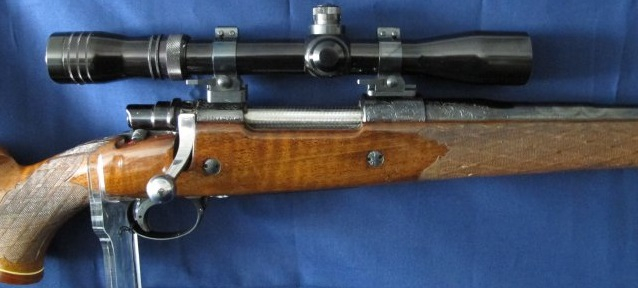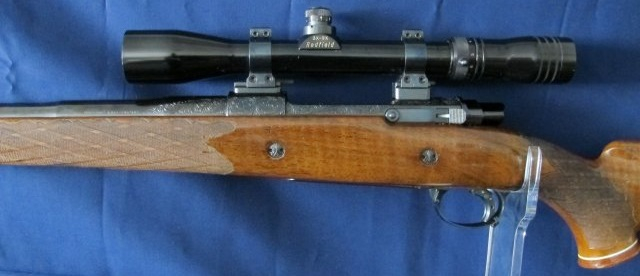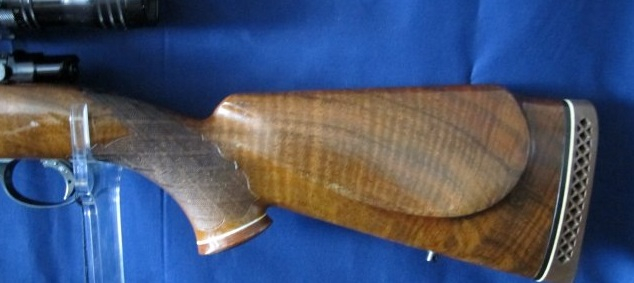




























Crassus invading Parthia, where he lost and when a he became a POW. The Parthians pored molten gold down his greedy mouth. Kinda fitting don’t you think? Grumpy
(Maybe we should do this to the guys who keep getting us into all these meaningless wars? Just a thought)
On Monday news came that the era of zero-tolerance was over. The National Shooting Sports Foundation heralded the announcement from the Trump Administration in Monday’s edition of Bullet Points.
NSSF praises the announcement today by the Department of Justice (DOJ) and Bureau of Alcohol, Tobacco, Firearms and Explosives (ATF) that the agencies are doing away with the Biden-era “zero-tolerance” policy that punished lawful and highly-regulated Federal Firearm Licensees (FFLs) for minor clerical errors.
The administration’s announcement also noted that the Biden-era regulatory policies on “engaged in the business” and pistol stabilizing braces would be reconsidered. Both of which were viewed – rightly – as regulatory overreach by the agency on issues that should have been addressed legislatively by Congress.
We’ll see how all this works out.
Same here:
Spurred by the Biden Administration’s redefining braced pistols as short-barreled rifles (SBRs), placing them under the auspices of the National Firearms Act (NFA), a U.S. Congressman and a U.S. Senator have filed companion bills in Congress to remove short-barreled rifles, short-barreled shotguns and so-called “any other weapons (AOWs)” from NFA regulation.
Considering the split in Congress I have little hope right now. Again, we’ll see.


Oscar-winner Gregory Peck was one of the most popular movie stars ever. His filmography includes epics like To Kill a Mockingbird, The Guns of Navarone, Twelve O’clock High, and Roman Holiday. He died in 2003 at age 87.
Like most movie stars, Peck was a left-wing Democrat. It’s tough to comprehend why that particular job seems to attract Leftists so, but it does. He considered running against Ronald Reagan for the governorship of California in 1970 but demurred. President Lyndon Johnson stated that had he won re-election in 1968 he intended to offer Peck the position of Ambassador to Ireland. Peck, for his part, later admitted that he likely would have taken the job.
Despite starring in several violent movies, Gregory Peck was a rabid gun control advocate. He championed an international moratorium on nuclear weapons as well. These lofty ideals are laudable on the surface, I suppose, but utterly unenforceable. Giving up your guns as an individual or your nukes as a superpower is a great way to get your butt kicked on scales both small and large.
Gregory Peck was married to Greta Kukkonen from 1942 until 1955. In 1955 he married Veronique Passani. He ultimately fathered five children. His sole daughter Cecilia is a producer, director, and actress. His grandson Ethan is an actor of some renown himself. While Ethan has played many roles on both the large and small screens, one of his most compelling was as Spock on Star Trek: Discovery and Star Trek: Strange New Worlds. Ethan Peck’s dad is Stephen, Gregory Peck’s son by his first wife. Strange New Worlds is a great show, by the way.
Nepotism specific to Hollywood has a name. They call the successful offspring of successful movie personalities Nepo Babies. The presupposition is that acting is likely not really all that hard, and that having a recognizable name or face is a great way to break into the business. Examples include Jamie Lee Curtis, Nicholas Cage, Lilly-Rose Depp, George Clooney, Scott Caan, Hailey Bieber, Robert Downey Jr, Scott Eastwood, and Liv Tyler. Each of these stars is descended from show business royalty. As they say, the nut usually doesn’t fall far from the tree. And then there was Stephen Peck.
One of the interesting reasons we enjoy such social turmoil these days is that, for the first time in human history, we’re no longer consumed with just not starving to death. In generations past folks were too preoccupied with securing food, clothing, and shelter to fret overly about preferred pronouns and the nuances of social justice. If you’re raised in opulence surrounded by flaming Leftists one might be forgiven for growing up to become a privileged flaming Leftist yourself. However, sometimes the Real World offers a hard lesson in reality.
Stephen Peck came of age in the mid-1960’s. When Stephen’s draft number came up his rich, famous, politically-connected dad could have almost assuredly gotten him out of his obligation. However, to his credit, Stephen bucked up and enlisted in the US Marine Corps. He first donned the uniform at age 22.
The younger Peck enjoyed some proper leadership capabilities, and he was soon commissioned as a Lieutenant with orders for Vietnam. The elder Peck was a vociferous opponent of US military involvement in Southeast Asia. However, with the realization that his son was going to war, Gregory stood behind both him and the troops with whom he served.
Many Hollywood types could not differentiate between government policy and the instruments of that policy. It is our Constitutionally-protected right to petition the government for redress. If you don’t like whatever it is the government is doing, then by all means become active in the process and change it. However, don’t take your frustrations out on the lowly grunts who do the fighting and the dying. I can tell you from personal experience, Uncle Sam doesn’t care about your politics. He just expects you to go where you’re told and do what you’re trained to do. Geopolitical niceties matter little to a soldier who is wondering if he will live to see another sunrise. 
It would have been nice to have had Jane Fonda figure that out before she crawled up onto that North Vietnamese antiaircraft gun. It would have been almost as nice to have had her apologize for such rank stupidity once she matured enough to do so. However, that was a bridge too far for her.
She did express “regret” for allowing herself to be photographed manning the antiaircraft gun. However, she spoke proudly of her Radio Hanoi broadcasts, her support of a Communist victory, and her attacks on American servicemen as war criminals. As apologies go, that seems tepid at best. Personally, I wasn’t much moved by it. By contrast, Stephen Peck actually did the deed. He trekked overseas and saw the elephant for himself.

Stephen is quick to point out that he didn’t volunteer. He was drafted, but he served with honor. He fought with the 1st Marine Division around Da Nang from 1969 into 1970. Like many combat vets, he had a tough time switching that off after he got home. His time in combat had a curious effect on his worldview.
Upon his return, Stephen launched himself into the only world he had ever really known. In 1972 he enrolled in a grad school cinema program with the intent of becoming a documentary filmmaker. He made a decent living in the film industry up until 1990 when he helmed a documentary film on the unique culture among homeless veterans living on the beach in Venice, California.
Prior to that time, Peck had kept the details of his military service to himself. Literally nothing triggers a sense of admiration in me like learning that a new acquaintance served our country in uniform. However, in the sorts of circles in which Peck moved, telling folks that he had gone downrange for Uncle Sam was not the best ice breaker. Here is what he had to say on the subject, “I didn’t tell a lot of people I served in Vietnam because in those years you didn’t do that. Around that time those feelings about the war and Vietnam came back to me and I began to think about my experience and talking with other veterans, and produced a film about the combat experience.”
Meeting those homeless vets changed him. Among these hopeless souls he imagined his brothers with whom he had served in the Marines. He later said, “I was making documentary films so I was an observer on the problem but I wasn’t an active participant in solving the problem.” His felt so strongly about the subject that in his mid-forties he quit his job and enrolled at the University of Southern California to earn a degree in social work. His mission now became supporting and encouraging at-risk veterans.
Today Stephen Peck is CEO of US Vets, an energetic non-profit dedicated to serving homeless veterans. From their website–nearly 38,000 military veterans are homeless in the US today. That’s roughly 9% of the country’s homeless population. US Vets supports roughly 20,000 of those homeless vets each year. They have provided 393,093 bed nights for eligible veterans and have successfully placed 1,236 previously homeless vets in jobs. US Vets has secured 3,061 permanent housing solutions and served 440,141 meals. They have also provided some 57,782 counseling sessions to help homeless veterans get back on their feet.
US Vets has eleven different hubs supporting veterans around the country. They always begin with shelter. Once a veteran has a safe place to call home he or she can begin down the road to economic self-sufficiency. Along the way, US Vets offers services in support of mental health and wellness as well as job training and workforce development.

Solving the homeless problem among American military veterans is a Gordian task. It is easy to feel overwhelmed by its scope. However, Stephen Peck and US Vets attempt to solve this thorny cultural challenge one veteran at a time. It’s indeed a gargantuan problem, but these guys are steadily chipping away at it.
Stephen Peck is Hollywood royalty. Had he chosen to do so, he could have coasted on his famous dad’s trust fund and lived out a life of comfort and leisure someplace. However, unlike so many among the Leftist elites, Stephen Peck actually went to war. Along the way, he saw firsthand how Americans from all walks can come together for a common objective and make some powerfully enduring relationships along the way.
You can’t swing a dead cat in Hollywood without hitting some vapid idiot who is more than willing to shoot a brief public service announcement instructing everyone else in what they need to do to solve society’s many manifest ills. Once that PSA is a wrap they climb into their private jets and blast off back to wherever it is they spend their money. 
By contrast, Stephen Peck was sufficiently burdened by what he saw among homeless veterans that he quit his job, went back to school, and devoted the rest of his professional life to making a real difference. Despite the apparent disparity in their political leanings, I suspect his Old Man would be proud.